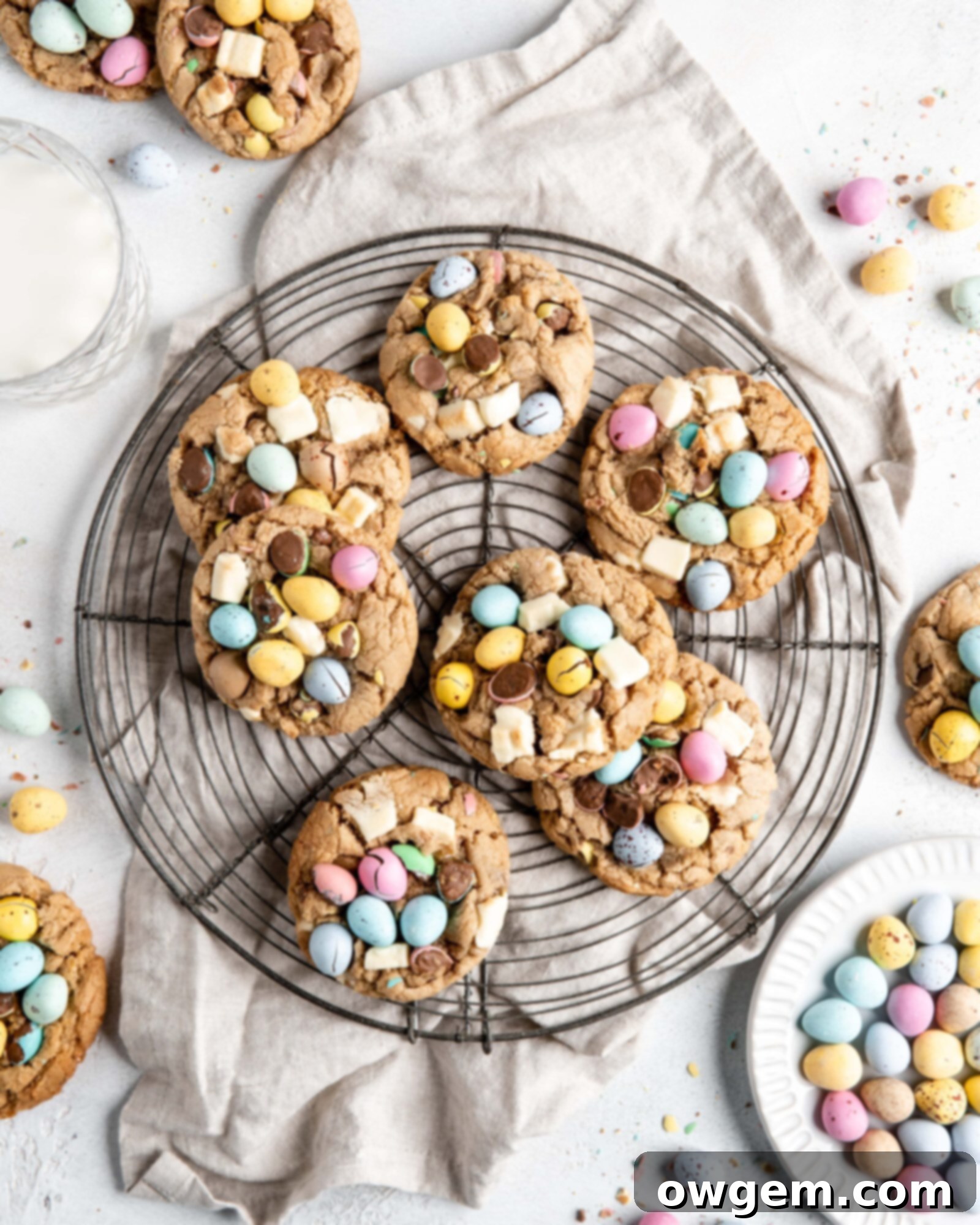Ultimate Chewy Cadbury Mini Egg Cookies: Your Perfect Easter Treat Recipe
Step into the delightful world of Easter baking with these incredibly sweet and charming Mini Egg Cookies! These festive treats offer a perfect balance of chewy and tender textures, generously studded with the beloved Cadbury mini eggs and creamy white chocolate chunks. Not a fan of white chocolate? No problem! Feel free to substitute it with your favorite semi-sweet or milk chocolate for a different twist. These cookies are guaranteed to be a crowd-pleaser at any Easter gathering or simply as a joyous homemade snack.

Preparing Your Cadbury Mini Eggs for Baking
Nothing signals the arrival of spring and Easter quite like the appearance of Cadbury mini eggs in grocery stores! These iconic candies bring a nostalgic charm to any dessert, and our Mini Egg Easter Cookies truly make the most of their colorful crunch and sweet flavor. Incorporating them into your cookie dough requires a little preparation to ensure they’re perfectly distributed and provide that delightful texture in every bite.
To successfully use mini eggs in this recipe, you’ll need to roughly chop them. While this might sound like a straightforward task, I’ve found that chopping them with a knife can be surprisingly challenging and tedious due to their hard candy shell. For an easier and more efficient method, simply place the mini eggs into a sturdy large plastic bag. Then, using a meat mallet or a rolling pin, gently but firmly tap them until each egg is broken into at least two or three pieces. This method not only saves time but also ensures a good mix of smaller crumbs and larger chunks, adding both color and texture to your finished cookies.
Baking Your Perfect Mini Egg Cookies: A Step-by-Step Overview
Crafting these delightful Mini Egg Cookies is a straightforward process, perfect for bakers of all experience levels. The key lies in careful ingredient preparation and following the steps to achieve that ideal chewy and tender texture. Below is a concise overview of the baking process. For precise measurements and detailed instructions, please refer to the full recipe card further down this page.
1. Combine Wet Ingredients: Start by mixing your sugars with melted butter. For an extra layer of flavor, consider browning your butter beforehand – a simple step that yields rich, nutty notes. Beat these together until they’re well combined and creamy.
2. Incorporate Eggs and Vanilla: Add the eggs and a splash of vanilla extract to the butter-sugar mixture. Beat thoroughly until everything is fully incorporated, ensuring a smooth base for your cookie dough.
3. Introduce Dry Ingredients: In a separate bowl, whisk together the all-purpose flour, baking soda, baking powder, and salt. Gradually add this dry mixture to your wet ingredients, mixing until just combined. Be careful not to overmix, as this can lead to tough cookies.
4. Fold in the Stars: Gently fold in your roughly chopped Cadbury mini eggs and white chocolate chunks. Ensure they are evenly distributed throughout the dough, ready to burst with flavor in every bite.
5. Scoop, Chill, and Bake: Scoop the cookie dough onto a prepared baking sheet. It’s crucial to chill the dough in the fridge for at least 30 minutes before baking. This resting period is vital for texture and flavor, preventing excessive spreading and ensuring your cookies turn out perfectly chewy. After chilling, simply transfer to the oven and bake until golden brown.

The Essential Step of Resting Your Mini Egg Cookie Dough
We understand the irresistible urge to pop those freshly mixed mini egg cookie dough balls straight into the oven. After all, who wants to wait when delicious cookies are just minutes away? However, resisting this temptation is perhaps the most crucial step in achieving the perfect texture and flavor for your cookies. Allowing the dough to rest in the fridge or freezer is a non-negotiable part of this recipe for several scientific reasons that profoundly impact the final product.
During the chilling period, several beneficial transformations occur within your cookie dough. Firstly, it gives the flour ample time to fully absorb any free-floating liquid present in the dough. This absorption leads to a more uniform and consistent dough structure, which in turn results in cookies that hold their shape better and spread less during baking. Think of it this way: less free-floating liquid means a less runny dough, directly translating to less spreading in the oven and a thicker, chewier cookie.
Beyond structure, chilling the dough also subtly dehydrates it. This concentrated effect intensifies the flavors of all the ingredients – from the butter and sugars to the vanilla and, of course, the vibrant Cadbury mini eggs. The flavors meld together more harmoniously, resulting in a more complex and satisfying taste experience. It’s like marinating meat; the longer it sits, the deeper the flavor penetrates.
Finally, and perhaps most visibly, the cooling period solidifies the fats in the dough. When these chilled, solidified fats enter a hot oven, they take longer to melt than fats in room-temperature dough. This delay in melting means the cookies spread out significantly less, allowing them to retain a beautiful, thick shape and develop that desirable chewy interior and slightly crispy edge. Skipping this step often results in flat, overly crispy cookies that lack the rich texture we’re aiming for.

Optional: Elevating Flavor with Browned Butter
For those looking to add an extraordinary depth of flavor to these already delicious Easter cookies, consider an optional yet highly recommended step: browning the butter. This simple technique transforms ordinary butter into a rich, nutty, and subtly caramel-flavored ingredient that will elevate your cookies to a gourmet level.
The process of browning butter involves heating it gently until the milk solids separate from the butterfat and begin to cook. As these milk solids sink to the bottom of the pan, the heat causes them to undergo the Maillard reaction – a complex chemical reaction responsible for the browning and flavor development in many foods. Essentially, these milk solids caramelize, creating a butter that boasts a deep, amber color and an intensely rich, almost toffee-like flavor with delightful nutty undertones.
While it might sound fancy, browning butter is surprisingly easy and shouldn’t intimidate even novice bakers! To do it, simply add cubed, unsalted butter (preferably at room temperature for even melting) to a small, light-colored saucepan over medium heat. The light color of the pan helps you monitor the browning. Allow the butter to melt, then continue to simmer, stirring constantly with a whisk or spatula. Constant stirring is key to ensure even cooking and prevent the milk solids from burning. You’ll notice the butter will foam, then the foam will subside, and you’ll see tiny brown specks forming at the bottom of the pan. Keep stirring until the butter turns a beautiful, fragrant nutty brown. If excessive foam obscures your view, periodically remove the pan from the heat for a moment to check the color underneath.
Once achieved, immediately remove the pan from the heat to prevent further cooking and burning. Transfer the browned butter (including all the nutty brown bits!) to a heat-safe bowl or measuring cup. Allow it to cool in the fridge for about 15 minutes. It should still be liquid and slightly warm to the touch, but not so hot that it would cook your eggs when added to the sugar mixture. The browned butter adds a sophistication that beautifully complements the sweetness of the mini eggs and white chocolate.

Mastering the Right Amount of Flour for Perfect Cookies
Achieving the ideal texture in these Mini Egg Cookies – perfectly chewy and tender – hinges significantly on one often-overlooked detail: the precise measurement of flour. Flour provides the structure for your cookies, and an imbalance can drastically alter the outcome. Too much flour will result in cookies that are dry, dense, and tough, resembling hockey pucks more than delightful treats. Conversely, too little flour means your cookies will lack sufficient structure, leading to excessive spreading and a thin, flimsy texture.
The secret to consistently using the perfect amount of flour every single time is to weigh it using a kitchen scale. Volumetric measurements (using measuring cups) are notoriously inaccurate for flour. Depending on how packed the flour is, a cup measure can sometimes over-measure by as much as 100%! This means you could inadvertently be adding double the required flour, almost guaranteeing a dry, tough, and disappointing cookie. By measuring flour by weight, you ensure an exact and consistent amount, which is critical for the delicate balance of ingredients that creates perfectly chewy and tender cookies, every. single. time.
If you don’t own a kitchen scale, and we highly recommend investing in one for baking precision, it’s essential to use proper volumetric measuring practices to minimize error. Avoid scooping the measuring cup directly into the bag or container of flour, as this compacts it. Instead, use a spoon to lightly scoop and aerate the flour into your measuring cup until it’s overflowing. Then, use the straight edge of a knife or a ruler to level off the top. This method helps to achieve a measurement closer to the intended weight and prevents over-packing.

Get the Recipe:
Mini Egg Easter Cookies
Pin
Rate
Ingredients
- 1 cup (227g) Unsalted Butter, at room temperature
- 3/4 cup (165g) Dark Brown Sugar
- 3/4 cup (150g) White Sugar
- 2 Large Eggs
- 1 tsp Vanilla Extract
- 2½ cups + 1 tbsp (310g) All Purpose Flour,, measured correctly (see above)
- 3/4 tsp Baking Soda
- 3/4 tsp Baking Powder
- 1 tsp Salt
- 1 cup (180g) Mini Eggs,, roughly chopped
- 1/2 cup (70g) Roughly Chopped White Chocolate
Instructions
-
In a small saucepan over medium heat, add butter and bring to a boil. Continue heating over medium heat, stirring constantly until the butter has turned a nutty brown color. It may be hard to see the color if your butter is foaming a lot, so periodically take it off the heat to check the color. Remove from heat and allow to cool slightly in the fridge for 15 minutes. If you do not want to brown the butter, simply just melt the butter instead.
-
In a medium to large sized bowl, add in flour, baking soda, baking powder and salt. Whisk well to combine, then set aside.
-
In a large mixing bowl, add the browned/melted butter, brown sugar, and white sugar, and beat with a hand mixer until combined.
-
Add eggs and vanilla, then beat until well-combined, scraping at the edges periodically. Add in the flour mixture and mix on low until combined, scraping at the edges. Ensure it is well combined, but do not overmix. Add in the mini eggs and chocolate, and fold with a spatula until well dispersed.
-
Prepare a baking sheet with parchment paper. Using your hands or a scoop, arrange cookies to be about 2 tbsp each. Place all the cookies onto the baking sheet (do not worry about arrangement yet), and place into the fridge for 30 minutes to rest (don’t skip, see above!)
-
Preheat oven to 350°F.
-
Remove baking sheet from the freezer, and arrange cookies evenly onto 3 baking sheets fitted with parchment paper (I do 6-8 per sheet). Place into the oven and bake for 13 minutes.
-
Note: If baking in batches, keep cookies cold before baking by keeping them in the fridge.
Tips for Achieving Perfect Mini Egg Cookies Every Time
Even with a fantastic recipe, a few extra tips can make all the difference between good cookies and truly unforgettable ones. Keep these pointers in mind for your next batch of Cadbury Mini Egg Cookies:
- Room Temperature Ingredients: Ensure your butter and eggs are at room temperature. This allows them to cream together more effectively, creating a smoother, more emulsified dough that traps air better, leading to lighter, more evenly textured cookies.
- Don’t Overmix: Once you add the dry ingredients to the wet, mix only until just combined. Overmixing develops the gluten in the flour, which can result in tough, dense cookies.
- The Importance of Chill Time: As discussed, the resting period in the fridge is absolutely crucial. Don’t skip it! It prevents spreading, enhances flavor, and sets the stage for that perfect chewy texture.
- Don’t Overbake: Cookies continue to cook slightly even after they’re removed from the oven. For chewy cookies, take them out when the edges are just set and lightly golden, but the centers still look a little soft and underbaked. They will firm up as they cool.
- Even Scooping: Use a cookie scoop to ensure uniform cookie size. This guarantees even baking, so all your cookies are done at the same time and look aesthetically pleasing.
- Fresh Baking Agents: Make sure your baking soda and baking powder are fresh. Expired leavening agents won’t activate properly, leading to flat, dense cookies.
Delicious Variations for Your Easter Cookies
While the classic Cadbury Mini Egg Cookie is undeniably delicious, feel free to get creative and customize your batch with these exciting variations:
- Chocolate Choices: If white chocolate isn’t your preference, easily swap it for milk chocolate chips, semi-sweet chocolate chunks, or even dark chocolate for a less sweet contrast to the mini eggs. A mix of different chocolates can also be delightful!
- Nutty Additions: For an extra crunch and depth of flavor, fold in half a cup of chopped pecans, walnuts, or almonds along with the mini eggs and chocolate.
- Extra Festivity: Enhance the Easter theme by adding a quarter cup of pastel-colored sprinkles to the dough or pressing them onto the tops of the scooped dough balls before chilling.
- Citrus Zest: A teaspoon of orange or lemon zest can brighten the flavor profile, offering a subtle tang that complements the sweetness of the mini eggs.
- Extract Experiments: Beyond vanilla, consider adding a touch of almond extract for a marzipan-like note, or a hint of coconut extract for a tropical twist.
Storing Your Cadbury Mini Egg Cookies
To keep your freshly baked Cadbury Mini Egg Cookies as delicious as the day they were made, proper storage is key. Whether you’re planning to enjoy them over a few days or save them for later, here’s how to ensure their freshness and amazing texture:
- At Room Temperature: Once completely cooled, store the cookies in an airtight container at room temperature for up to 3-5 days. To maintain their chewiness, you can place a slice of bread in the container with them; the cookies will absorb moisture from the bread.
- In the Refrigerator: While not typically necessary for short-term storage, you can store baked cookies in an airtight container in the refrigerator for up to a week. They may become slightly firmer, but a quick warm-up in the microwave can restore some of their softness.
- Freezing Baked Cookies: For longer storage, baked cookies freeze beautifully. Once cooled, arrange them in a single layer on a baking sheet and freeze until solid (about 1-2 hours). Then, transfer them to a freezer-safe airtight container or heavy-duty freezer bag, separating layers with parchment paper to prevent sticking. They can be stored for up to 2-3 months. Thaw at room temperature or warm briefly in the oven for a “fresh out of the oven” experience.
- Freezing Cookie Dough: You can also freeze the unbaked cookie dough balls! Scoop the dough as directed, place them on a parchment-lined baking sheet, and freeze until solid. Transfer the frozen dough balls to a freezer-safe bag. When ready to bake, place frozen dough balls on a baking sheet and bake as usual, adding an extra 2-4 minutes to the baking time. No need to thaw!
Frequently Asked Questions About Mini Egg Cookies
Here are some common questions you might have when making these festive Mini Egg Cookies:
- Can I use other types of chocolate eggs besides Cadbury Mini Eggs?
Absolutely! While Cadbury Mini Eggs are iconic, you can certainly experiment with other candy-coated chocolate eggs or even regular chocolate candies. Just ensure they are roughly chopped for even distribution and to prevent them from sinking to the bottom of the cookie. - What if I don’t have a hand mixer or stand mixer?
You can still make these cookies! The butter and sugar can be creamed together using a sturdy whisk and some elbow grease. Just ensure the mixture is light and fluffy before adding the eggs. - My cookies spread too much. What went wrong?
Excessive spreading is often due to warm butter, not chilling the dough long enough, or too little flour. Ensure your butter is at room temperature (not melted unless browned and then re-chilled), always chill the dough for the recommended time, and measure your flour by weight for accuracy. - Can I make these cookies gluten-free?
While this recipe is developed with all-purpose flour, you can try substituting it with a 1:1 gluten-free baking flour blend that contains xanthan gum. Results may vary slightly in texture, but many bakers have success with this substitution. - How do I ensure my mini eggs don’t burn?
Roughly chopping the mini eggs helps, as smaller pieces are less likely to sit on the surface and burn. Also, ensure you don’t overbake the cookies. If you notice any burning, you might need to adjust your oven temperature or baking time slightly.
We hope these tips and variations help you create the most delightful batch of Cadbury Mini Egg Cookies this Easter season. Enjoy the process of baking and the joy of sharing these vibrant, chewy, and utterly delicious treats!


